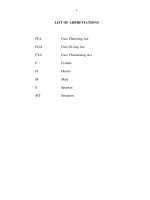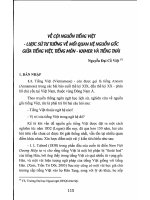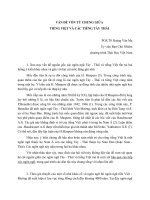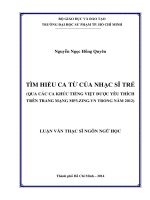Sử dụng các chiến lược giao tiếp lịch sự trong cách thức mặc cả giữa tiếng Anh và tiếng Việt
Bạn đang xem bản rút gọn của tài liệu. Xem và tải ngay bản đầy đủ của tài liệu tại đây (866.23 KB, 81 trang )
1
MINISTRY OF EDUCATION AND TRAINING
HAI PHONG PRIVATE UNIVERSITY
DEPARTMENT OF FOREIGN LANGUAGES
ISO 9001:2008
SCIENTIFIC RESEARCH
POLITENESS STRATEGIES APPLIED IN MAKING
A BARGAIN IN ENGLISH AND VIETNAMESE.
(Sử dụng các chiến lược giao tiếp lịch sự trong cách thức mặc cả
giữa tiếng Anh và tiếng Việt)
By: Nguyễn Thị Thu Huyền, M.A.
Haiphong, December 2010
2
Abstract
Based on the theoretical background of speech act, politeness in the light of cross-cultural
communication, this study investigates the similarities and differences in making a bargain in
Vietnamese and American language and culture.
Data used in this study are collected via questionnaires. To investigate the dimensions
thoroughly, we take informants’ social parameters such as age, sex, marital status, occupation,
living area, and knowledge of foreign languages into consideration.
The findings of all the investigated aspects are presented and cross-culturally compared.
The common belief is reassured that the American with their Western cultural features prefer
negative politeness strategies whereas the Vietnamese with their Asia Eastern ones prefer positive
politeness strategies. The social distance among various communicating partners has more
influence on the Vietnamese than on the American, which induces them to apply different
appropriate strategies. However, interactions with communicating partners of different social
distance still remain the American to be more negative politeness oriented.
This study, hopefully contributes to helping interlocutors avoid communication breakdowns in
Vietnamese-American cross-cultural communication. Then, several activities in teaching English,
particularly English for Business at Hai Phong Private University with the situations of sales and
price negotiation are suggested.
3
Acknowledgements
I would like to take this opportunity to thank all the following people for their great
supports during my completion of this scientific research.
First and foremost, I would like to express my deep gratitude Assoc. Prof. Dr. NguyÔn
Quang, my supervisor, for his clear guidance, insightful comments and dutiful supervision.
I would like to give my sincere thanks to all the lectures of Foreign Languages
Department- Hai Phong Private University for their knowledge, sharing teaching experiences and
their comments on my initial draft, from which I have acquired valuable knowledge and
inspiration to fulfill this research.
I would like to express my gratitude to my family, to many of my friends and colleagues,
for their valuable sharing and encouragements. My special thanks go to Mr Adrian Wurr, the
American educator; Mr David Bouchard, the Fulbright scholar for their comments and their help
with the collection of questionnaire in American English.
I wish to acknowledge the important contributions of both Vietnamese and American
informants, whose names I cannot mention here for the completion of this study.
NguyÔn ThÞ Thu HuyÒn
4
Table of contents
Abstract i
Acknowledgements ii
Table of contents iii
List of tables v
List of figures vi
Abbreviations vii
PART 1: INTRODUCTION
I. ration ale 1
II. Aims of the study 2
III. Scope of the study 2
IV. Methodology 3
V. Design of the study 3
Part 2: Development
Chapter 1: Language and culture in communication 4
1.1. Language and culture 4
1. 2. Communication, communicative functions of language, cross-cultural communication…6
Chapter 2: Making bargain as a speech act 8
1. Pragmatics, cross-cultural pragmatics 8
2. Speech act 9
2.1. Theory of speech acts 9
2.2. Classification of speech acts 10
2.3. Making bargain as a speech act 11
Chapter 3: Politeness strategies in making bargain 12
1. Theory of politeness 12
1.1. Politeness and face 12
1.2. Politeness principles 13
1.3. Positive politeness and positive politeness strategies 15
1.4. Negative politeness and negative politeness strategies 17
2. Sociological factors: Social distance (D), Relative power (P), and Ranking of imposition (R)
5
as politeness determinants 22
3. Realization of strategies in making bargain 23
Chapter 4: data collection, data analysis and discussion
1. Methodology 27
1.1. Research instrument 27
1.2. Procedure of data collection 27
1.3. Procedure of data analysis 28
2. data analysis and discussion 29
2.1. Use of strategies as seen from informants’ parameters 29
2.1.1. Politeness Strategies 29
2.1.2. Major cross-cultural similarities and differences 35
2.2. Use of strategies as seen from communicating partners’ parameters 36
2.2.1. Politeness Strategies 37
2.2.2. Major cross-cultural similarities and differences 41
3. Concluding remarks 43
Part 3: Conclusion
1. Overview of the findings 44
1.1. Politeness strategies in making a bargain 44
1.2. Effects of the communicating partners on informants in choosing politeness strategies
when making a bargain. 45
1.3. Informants’ status parameters. 46
2. Implications for cross- cultural communication 46
3. IMPLICATIONS FOR ELT 47
3.1. Cross cultural negotiation in business field 47
3.2. Activities of sales and price negotiation for learners, particularly for those of
English for Business 49
References 63
Appendix 1: Vietnamese survey questionnaire VIII
Appendix 2: English survey questionnaire X
APPENDIX 3: Summary Table of utterances collected from Informants XII
6
List of tables
Table 1: The five general functions of speech acts (following Searle 1979)
Table 2: Realization of strategies in making a bargain
Table 3: Distribution of informants with their status parameters
Table 4: Number of utterances collected from survey questionnaire
Table 5: Politeness strategies according to the parameter of age
Table 6: Politeness strategies according to the parameter of gender
Table 7: Politeness strategies according to the parameter of marital status
Table 8: Politeness strategies according to the parameter of occupation
Table 9: Politeness strategies according to the parameter of living area
Table 10: Politeness strategies according to the parameter of knowledge of FL
7
List of figures
Figure 1: Possible strategies for doing FTAs ( Brown and Levinson, 1987)
Figure 2: Possible strategies for doing FTAs (Nguyen Quang, 1999:130)
Figure 3: Politeness strategies in making a bargain to acquaintance
Figure 4: Politeness strategies in making a bargain to friend
Figure 5: Politeness strategies in making a bargain to neighbor
Figure 6: Politeness strategies in making a bargain to stranger
Figure 7: Politeness strategies in making a bargain to different communicating partners
8
Abbreviations
Am : American
FSA : Face Saving Act
FTA : Face Threatening Act
H : Hearer
NOR : Nonverbal Off-record
PPO : Negative Politeness Oriented
NPS : Negative Politeness Strategies
NPS+NPS : Negative Politeness Strategies+ Negative Politeness Strategies
NPS+PPS : Negative Politeness Strategies+ Positive Politeness Strategies
NPS+VOR : Negative Politeness Strategies+ Off-record
OR : Off-record
PPS+NPS : Positive Politeness Strategies+ Negative Politeness Strategies
PPS+PPS : Positive Politeness Strategies+ Positive Politeness Strategies
PPS+VOR : Positive Politeness Strategies+ Off-record
S : Speaker
SNPS : Single Negative Politeness Strategies
SPPS : Single Positive Politeness Strategies
Vie : Vietnamese
VOR : Verbal Off-record
9
Part1: introduction
x
x
i. Rationale
Any creatures on this earth, when forming a community, share their same language to
survive and to develop. Each type of animal has its own so-called language so that they can
recognize its specie. Language of bird is the sound of singing, of dog is the sound of barking, of
ocean animals such as dolphin, seal is the sound of lapping. Human being, the supreme animal,
by each ethnic group, territory has its own language of sounds, signs or symbols to communicate,
to support each other. It is also noted that language is the basic tool by which humans make
society function. In its most basic form, language is a tool humans have utilized, sometimes
effectively, sometimes not so effectively, to communicate their ideas, thoughts, and feelings to
others. Saville-Troike (in Samovar, L.A and Porter, R.E, 1991: 166) furthers this notion by
saying:
‚At the level of individuals and groups interacting with one another, the functions of
communication are related to participants’ purposes and needs. These include such categories of
functions as affect (conveying feelings or emotions), directive (requesting or demanding), poetic
(aesthetic), phatic (empathy and solidarity), and metalinguistic (reference to language itself).‛
Language also permits you to pool knowledge and to communicate with others who are
beyond the reach of your voice in space and time so that you need not rediscover what others have
already discarded. This capability is a key in making progress possible because it allows us to
learn from the past, and to communicate through time.
Language serves a number of cultural, communal, and societal functions. First, from the
cultural perspective, it is the primary means of preserving culture and is the medium of
transmitting culture to new generation. In Vietnamese families, parents talk with their children to
teach them the traditional family values such as the respect, the patriotism, the virtue of
worshipping their ancestors. In America, children learn the values of individualism and freedom
as the Americans’ identity from generation to generation. Second, it helps establish and preserve
community by linking individuals into communities of shared identity. Third, at the societal level,
it is important to all aspects of human interaction.
As you can see, language is a multifunctional tool that helps you satisfy a variety of needs.
Of which, conversation, therefore, is the most fundamental form of communication in daily
interaction because it provides you with the means of conducting human affairs. In such a kind of
human daily interaction, making a bargain is a subtle speech act. Different ethnic groups have
different ways to perform their daily interactions. The Western people, namely the American, to
certain extents, have different spoken language, different behaviors from those of Eastern people,
such as Vietnamese. In the field of cross- cultural communication, the degree of politeness
xi
xi
strategies applied is a significant factor. Therefore, an investigation into how to make a bargain
will partially contribute to raising communicative competence of language learners and their
better mutual understanding of an aspect of cultures. It is hoped that findings from the study will
help learners of English avoid potential cultural shock and communication breakdown.
II. Aims of the study
This research aims to:
- Investigate the specific situations of making a bargain with the degree of politeness strategies
applied by Vietnamese and American people.
- Compare and contrast strategies on how to make a bargain in the two languages and cultures in
order to clarify similarities and differences in the ways the Vietnamese and Americans make a
bargain in their daily life.
- Test the validity of the following hypotheses:
a. The Americans are more interested in negative politeness strategies, while the Vietnamese
in positive politeness strategies.
b. The Americans tend to be more direct in communication than the Vietnamese.
- Contribute to raising awareness of cross-cultural differences in communication among English
learners and potential interactants of international communication.
- Then suggest supplementary activities applied in teaching English, particularly for the learners
of English for Business in sales and price negotiation.
III. Scope of the study
- The study especially focuses on the degrees of politeness strategies used in making a bargain in
Vietnamese and American languages and cultures.
- The study focuses totally on the verbal aspect of the speech act. Paralinguistic and extra-
linguistic factors, though important, go beyond the scope of this study.
- In this sort of communication, making a bargain, the sociological factors such as ‚ranking of
impositions‛ and ‚relative power‛ are kept neutral while the factor ‚social distance‛ is taken
into consideration to investigate the degrees of the politeness strategies in this study.
xii
xii
IV. Methodology
The research project is based on both theoretical discussion and data analysis. The
theoretical background was selected with reference to both Vietnamese and foreign publications.
Data were collected and analyzed for the aim of comparing and contrasting the similarities and
differences between the two languages and cultures.
The ‘Quantitative’ and ‘Contrastive analysis’ are the main methods applied to pursue the
objectivity in a cross- cultural research.
All the interpretations, comments, and conclusions are drawn from:
- Relevant references
- Survey questionnaires
- Statistics, description and analysis of the collected data
- Personal observations and experience
- Discussion with colleagues, students
- Consultation with the supervisor
V. Design of the study
The study consists of three main parts:
Part 1: Introduction outlines the general background, the rationale, the methodology,
the aims, the scope and the design of the study.
Part 2: Development presents the theoretical background and discusses the data analysis
and findings. This part includes the following chapters
Chapter 1. Briefly presents language and culture in communication
Chapter 2. Briefly presents and discusses the theory of pragmatics, cross cultural
pragmatics, speech acts and making a bargain as a speech act.
Chapter 3. Politeness strategies in making a bargain
Chapter 4: Data collection, data analysis and discussion
Part 3: Conclusion summarizes the major findings of the study, suggest implication in teaching
English at HPU, particularly for the students of Business Administration.
xiii
xiii
Part 2: Development
In this part, language, culture and its relationship, the important factors in communication
are discussed briefly basing on the various perspectives of linguists. One may consider language
by the concept of systems, system of sounds, of signs, of symbols, or of rules, others may
consider language by its function. Culture is also regarded as a system, basic belief system,
shared background or as patterns of communicative behavior. Furthermore, theoretical
background of cross-cultural pragmatics, politeness strategies ( including 17 positive politeness
strategies and 11 negative politeness strategies) is presented to see making a bargain as a speech
act in the light of cross-cultural communication. The last chapter in this part deals with the data
analysis and findings. Implications for the teaching and learning of English by Vietnamese
learners will also be presented.
Chapter 1: Language and culture in communication
1.1. Language and culture:
Language is described as ‚the human faculty that enables us to exchange meaningful
messages with our fellow human beings by means of discourses and texts, which are structured
according to the rules and conventions of the particular language that we share with them.‛ by
Jackson and Stockwell (1996: 2). Another linguist, Widdowson (1996: 4) states that language is
so uniquely human, and it distinguishes us so clearly from other animals. He also claims that
what is particularly striking about language is the way it is fashioned as systems of signs to meet
the elaborate cultural and communal needs of human societies. ‚A language is distinctively
human‛, in Delahunty and Garvey’s words (1994: 15). Language is not only our main link with
the outside world, it is also a marker that distinguishes us from the other animal creatures we
share the world with.
According to Crystal (1992: 212), language is ‚the systematic, conventional use of
sounds, signs, or written symbols human society for communication and self- expression.‛
Delahunty and Garvey (1994: 11) share the idea of a language as a system of rules. Mc Arthurs
(1996: 523) asserts that language as a system of communication which users structured vocal
sounds and its embodiments in other media are writing, print and physical signs. Language,
supported by Schimidt and Richard’s point of view (1980: 161), is used ‚to build bridges, to
consolidate political regimes, to carry on arguments, to convey information from one person to
another, to entertain- in short, to communicate.‛
xiv
xiv
Culture, according to Fay (1996), ‚is a complex set of shared beliefs, values, and
concepts which enables a group to make sense of its life and which provides it with directions for
how to live‛. (in Holliday, A et al. (2004: 60)) This set might be called a basic belief system, such
a belief system can include items which are fully explicit and others which are not, and can
include matters of feeling and deportment as well as discursive claims about the world.
Culture, in relation to language, is emphasized by Richards et al. (1985: 94) as ‚the total
set of beliefs, attitudes, customs, behaviors, social habits,… of the member of a particular society
‛; by Levine and Adellman (1993) as ‚a shared background, e.g. national, ethic, religious,
resulting from a common language and communication style, customs, beliefs, attitudes and
values‛; and is evaluated and clarified by Nguyen Quang in ‘Intercultural Communication‛
(1998: 3).
Goodenough (1975) in Wardhaugh (1986: 217) describes ‚a society’s culture consists of
whatever it is one has to know or believe in order to operate in a manner acceptable to its
members‛
Basing on such perspectives, we should be fully aware of the link between culture and
communication. Culture is a set of human-made objective and subjective elements that in the past
have increased the probability of survival and resulted in satisfaction for the participants in an
ecological niche, and thus became shared among those who could communicate with each other
because they had a common language and they lived in the same time and place. Culture includes
the ‚subjective‛ elements- elements such as ‚values, attitudes, beliefs, orientations, and underlying
assumptions prevalent among people in a society. We can see that all the subjective cultural beliefs
and values you hold influence your interpretation of the world and interactions in it.
The relationship of language and culture can be obviously derived because language
functions as the principal means whereby we conduct our social lives. As Federico Fellini claims
‚A different language is a different view of life‛ (in Samovar, L.A and Porte, R.E , 1991: 164)‚A
society’s language is an aspect of its culture… The relation of language to culture is that of part
to whole‛ has been acknowledged by Goodenough (1957) (in Hudson, 1980: 83). Kramsch
(1998: 3) identifies this correlation by three aspects of language and culture as follow: (1)
language expresses cultural reality; (2) language embodies cultural reality; (3) language
symbolizes cultural reality.
Language usage and style reflect the personality of a culture in much the same way they
reflect the personality of an individual. Philipsen supports this view,
xv
xv
Cultural premises and rules about speaking are intricately tired up with cultural
conceptions of persons, agency, and social relations- that is, rules and beliefs about speech
articulate with a larger cultural code defining the nature of persons, whether and how it is that
humans can act efficaciously in their world of practice, and what are the possible and
appropriate ways in which individuals are linked together in social units. (cited in Samovar, L.A
and Porter, R.E 1991: 168).
Such relationship between language and culture is further emphasized because there is no
doubt, however, that there is a correlation between the form and content of a language and the
beliefs, values, and needs present in the culture of its speakers. From recognizing this
relationship, it is noted that language and culture are inseparable, language and culture have the
power to maintain national or cultural identity.
The link between language and culture is evident because language is the primary means
of instructing members of a society in culturally acceptable practices and behaviors for social
interaction, in the appropriate relationships to the physical environment. The sharing of a common
or similar worldview and system of values that only results in a shared ability for verbal
communication but also possible other forms of culturally determined ways of communication.
Nguyen Quang highly appreciates this correlation between language and culture: There is
an obvious correlation between cultural factors, language and communicative competence, which
requires an appropriate consideration. People are aware that one cannot master a language
without understanding of its cultural background, and that a strong impinge on any
communicative behavior, either verbal or non-verbal communication.) (NguyÔn Quang 2002:
10)
1. 2. Communication, communicative functions of language, cross-cultural communication
Communication is defined as ‚the exchange of ideas, information, etc. between two or
more persons‛ (Richards et al., 1992: 64).
To our observation, communication can take place in many different ways. Generally
speaking, two categories of communication can be identified. The first is verbal communication;
that is communication using language and speech to share or exchange information. The second
is non-verbal communication; that is communication without use of language but depending
rather on other channels such as body language, eye contact, physical appearance, attitude
distance and physical contact. In our daily situations, we apply different ways, either verbal or
non-verbal communication, however in many cases both, to different partners.
xvi
xvi
Certainly, each human language is a system for communication. If communication is to be
successful, the people involved need to share the same referential meaning of the words they are
using. To communicate effectively the speakers share the linguistic knowledge, interaction skills
and cultural knowledge.
Samovar, L.A and Porte, R.E (1991: 12) hold that human communication is the process
through which symbols are transmitted for the purpose of eliciting a response.
The importance of communication on human behavior is dramatically underscored by Keating
when she writes ‚Communication is powerful: It brings companions to our side or scatters our
rivals, reassures or alerts children, and forges consensus or battle lines between us‛ (cited in
Samovar, L.A and Porter, R.E, 1991: 12). What she is mentioning is that communication- your
ability to share your beliefs, values, and feelings- is the basis of all human contact.
The fact that language is the primary means people use to communicate with one another
may seem patently obvious. Yet, the relational dynamics between language and communication
are such a part of your everyday life and behavior that you probably do not consciously recognize
them. Our talking is the primary means of interactions between people. Speakers use language to
convey their thoughts, feelings, intentions, and desires to others. It links interlocutors in a
dynamic, reflexive process. We learn about people through what they say and how they say it; we
learn about ourselves through the ways other people react to what we say; and we learn about our
relationships with others through the give- and- take of communicative interactions.
xvii
xvii
Chapter 2: Making a bargain as a speech act
1. Pragmatics, cross-cultural pragmatics
By the most widely-known definitions, pragmatics were: meaning in use and meaning in
context. By distinguishing pragmatics with semantics, pragmatics is approach to studying
language’s relation to the contextual background features. Semantics is the study of the words
meaning by themselves, out of the context, as they are in a dictionary.
Many linguists, namely Leech (1983: 6), Levinson (1983: 32) hold the view that
pragmatics concentrates on aspects of meaning with the consideration of physical and social
factors as contextual background features, speakers or hearers.
According to Leech (1983: 6), meaning in pragmatics and meaning in semantics distinct
by the way ‚Meaning in pragmatics is defined relative to speaker or user of the language,
whereas meaning in semantics is defined purely as property of expressions in a given language,
abstraction from particular situations, speakers, or hearers‛.
In the words of Levinson (1983: 32), pragmatics, ‚a theory of language understanding
that takes context into account, in order to complement the contribution that semantics makes to
meaning‛
As Crystal (1992: 310) shares his perspective of pragmatics,
‚Pragmatics is the study of language from the point of view of the users- especially of the
choices they make, the constraints they encounter in using language in social interaction,
and the effects their use of language has on the other participants in an act of
communication ‛.
Richards et al. (1992: 248) points out the fields which pragmatics studies:
1. How the interpretation and use of utterances depends on knowledge of the real world.
2. How speakers use and understand speech acts.
3. How the structure of sentences is influenced by the relationship between the speaker and
the hearer.
Therefore, sharing the same point of view, Fairclough (1989), in the third extract, says
that the study of speech acts is a centre part of pragmatics, as well as cross-cultural pragmatics.
He refers to the multi-functionality of speech acts, and then focuses on the way they are related to
the co-text, the inter-textual context, and the situational and cultural background context. He sees
the social factors that influence the use of indirect speech acts in terms of power relations, and the
xviii
xviii
discourse type dictates the conventions for speech acts, and that the conventions reflect the
participants’ ideology and social relationship. (cited in Cutting, J, 2002: 119)
In the words of Yule, cross- cultural pragmatics is ‚the study of ‚differences in
expectations based on cultural schemata‛ and ‚the ways in which meaning is constructed by
speakers from different cultures‛ (Yule, 1996: 87).
Wierzbicka (1991: 26) believes in the idea of ‚different cultures, different languages,
different speech acts‛ because different cultures find expression in different systems of speech
acts, and that different speech acts become entrenched, and, to some extent, codified in different
languages. What is seen as more remarkable today is the field of cross-cultural pragmatics, the
extent of cross-linguistic and cross-cultural differences in ways of speaking. Wierbicka
emphasizes that ‚Today, it is increasingly accepted that those diversities in ways of speaking and
interacting are not superficial at all and that they can be accounted for, above all, in terms of
different cultural attitudes and values; and the cultural relativity in the field of interaction is
increasingly seen as a reality and an important subject for investigation‛. (Wierbicka 1991: vi)
2. Speech acts
2.1. Theory of speech acts
Austin (1962) defined speech acts as the actions performed in saying something. Speech act
theory said that the action performed when an utterance is produced can be analyzed on three
different levels. The first level of analysis is the words themselves. This is the locution, ‘what is
said’, the form of the words uttered; the act of saying something is known as the locutionary act.
The second level is what the speakers are doing with their words. This is the illocutionary force,
‘what is done in uttering the words’, the function of the words, the specific purpose that the
speakers have in mind. The last level of analysis is the result of the words. This is known as the
perlocutionary act, ‘what is done by uttering the words’; it is the effect on the hearer, the
hearer’s reaction. The three acts are closely related because when uttering ‚S says something to
H; in saying something to H, S does something; and by doing something, S affects H‛(Bach &
Harnish, 1979: 3)
As Blum-Kulka evaluates,
‚Speech acts have been claimed by some (Austin, 1962; Searl, 1962, 1957) to operate by
universal principles, and claimed by others to vary in conceptualizations and verbalizations
across cultures and languages (Green, 1975; Wierzcika, 1985). Their modes of performance
carry heavy social implications (Ervin-Tripp, 1976) and seem to be ruled by universal principles
of cooperation and politeness (Brown and Levinson, 1978; Leech, 1983). And yet, cultures have
xix
xix
been shown to vary drastically in their interactional styles, leading to different preferences for
modes of speech act behavior. Culturally colored interacional styles create culturally determined
expectations and integrative strategies; and can lead to breakdowns in intercultural and
interethnic communication (Grumperz, 1978)‛ (Blum-Kulka et al., 1989: 1)
2.2. Classification of speech acts
Austin (1962: 151) classifies speech acts by their five functions namely: verdictives (e.g. assess,
appraise,…) exercitives (e.g. command, direct, …), commissives (e.g. promise, propose,…),
behabitives (e.g. apologize, thank,…), and expositives (e.g. accept, agree,…).
Searle’s (1976) solution to classifying speech acts was to group them in the five following macro-
classes (clarified in Cutting, J, 2002: 16-17):
Declarations These are words and expressions that change the world by their very
utterance, such as ‘I bet’, ‘I declare’ ‘I resign’…
Representatives These are acts in which the words state what the speaker believes to be
the case, such as ‘describing’, ‘claiming’, ‘hypothesizing’, ‘insisting’, ‘predicting’.
Commissives This includes acts in which the words commit the speaker to future action,
such as ‘promising’, ‘offering’, ‘threatening’, ‘refusing’, ‘vowing’ and ‘volunteering’.
Directives This category covers acts in which the words are aimed at making the hearer do
something, such as ‘commanding’, ‘requesting’, ‘inviting’, ‘forbidding’, ‘suggesting’ and so on.
Expressives This last group includes acts in which the words state what the speaker feels,
such as ‘apologizing’, ‘praising’, ‘congratulating’, ‘deploring’, and ‘regretting’.
Sharing the same view on such classification by Searle (1979), Yule (1997: 55)
summarizes those five fundamental functions of speech acts as follows:
Speech act type
Direction of fit
S= speaker
X= situation
Declarations
Representatives
Expressives
Directives
Commissives
Words change the word
Make words fit the world
Make words fit the world
Make the world fit words
Make the world fit words
S causes X
S believes X
S feels X
S wants X
S intends X
Table 1: The five general functions of speech acts (following Searle 1979)
2.3. Making a bargain as a speech act
xx
xx
Basing on Searle’s classification (1976), as a speech act, making a bargain belongs to the
type of directives, i.e. ‚those kinds of speech acts that speakers use to get someone else to do
something. They express what the speakers want. And in using a directive, the speaker makes
the world fit words‛ (G.Yule, 1996:53).
Bargaining is considered to be one of the universals of interpersonal communication, in
realization of the politeness principle. Bargaining exchanges is regarded as an illocutionary act
performed by a speaker to express their want of purchasing goods at cheaper price. Buyer (S)
employ appropriate communication strategies, in particular, politeness strategies, to achieve a
successful bargain to their expectations. Exchanging bargain is a complex act, potentially
involving both positive as well as negative feelings on the part of the buyer (S) and the seller (H).
Therefore, making a bargain is a face-threatening act, which may appear to either speaker or
hearer. In a certain society of highly appreciated male, women were more likely
to look at
bargaining as a manifestation or sign of one's housekeeping
skills and that their more extensive
use of insisting strategies
of bargaining is seen as a daring act of assertiveness. Meanwhile, men
feel that such strategies could be face threatening and reduce
their inherited social power and
superiority.
The act of making a bargain is universal as a daily life activity. However, in cross-cultural
communication, this speech act, like any others, is affected by the culture to which the language
belongs and it may differ from one society to another. Basing on this assumption, a way of
bargaining, which is required in Vietnamese culture, may be more or less appropriate in
American culture. The different aspects of the act of bargaining in the two cultures, in particular
situation, will be discussed in detail in this study.
Chapter 3: Politeness in making a bargain
xxi
xxi
1. Theory of politeness
1.1. Politeness and face
Many linguists share their understanding and their concern on the concept of politeness.
Brown and Levison (1990: 2), in their introduction to ‚Politeness- Some Universals in Language
Usage‛, emphasize that ‚the issues of politeness raise sociological speculations of this scale, they
also touch on many other interests and many other fields.‛
Cutting (2002: 44-45) views that ‚in pragmatics, when we talk of politeness, we do not
refer to the social rules of behavior, we refer to the choices that are made in language use, the
linguistic expressions that give people space and show a friendly attitude to them‛.
It is true to say that politeness is a pragmatic phenomenon. Politeness lies not in the form and the
words themselves, but in their function and intended social meaning.
Politeness, in terms of cultural aspect, is defined as ‚a fixed concept, as in the idea of
‘polite social behavior’, or etiquette, within a culture‛ (Yule, 1996: 60).
Richards (1985:281) identifies politeness as ‚the attempt to establish, maintain,
and save face during conversation‛. Brown and Levinson (199) analyze politeness and say that in
order to enter into social relationships, we have to acknowledge and show an awareness of the
face.
‘Face’, the public self-image that every member wants to claim for himself, consisting in two
related aspects:
Negative face: the basic claim to territories, personal preserves, rights to non-
distraction- i.e. to freedom of action and freedom from imposition
Positive face: the positive consistent self-image or ‘personality’ (crucially including the
desire that this self-image be appreciated and approved of) claimed by interactants.
We should be aware of the fact that it is a universal characteristic across cultures that
speakers should respect each other’s expectations regarding self-image, take account of their
feelings, and avoid face threatening acts.
Cutting (2002: 45) analyzes the view of Brown and Levinson (1990) of politeness and face:
‚ When face threatening acts (FTAs) are unavoidable, speakers can redress the threat with
negative politeness (which does not mean being impolite) that respects the hearer’s negative
face, the need to be independent, have freedom of action, and not be imposed on by others. Or
they can redress the FTA with positive politeness, that attends the positive face, the need to be
accepted and liked by others, treated as a member of the group, and to know one’s wants are
shared by others‛.
xxii
xxii
1.2. Politeness principles
In this section, politeness rules by Lakoff (1973b), and politeness principles by Leech
(1983) are taken into consideration so that any potential face threat involving in interpersonal
interactions might be mitigated to the lowest extent. Lakoff (1973b, in Green, 1989: 142-144)
describes three different rules a speaker might follow in choosing to be polite.
Rule 1: Don’t impose is appropriate to situations where there is an acknowledged difference in
power and status between participants. According to this rule, S who is being polite will avoid,
mitigate or ask permission, or apologize for making A do anything which A does not want to do.
Rule 2: Offer options, a more informal politeness rule, is appropriate to situations in which the
participants’ status and power are approximately equal but not socially close. It refers to
expressing oneself in such a way that one’s opinion or request can be ignored without being
contradicted or rejected.
Rule 3: Encourage feelings of camaraderie, appropriate to intimates or close friends, attaches to
the governing principle that participants not only show an active interest in the other, by asking
personal questions and making personal remarks, but also show regard and trust by being open
about details of one’s own life, experiences, feelings, and the like.
According to Leech (1983: 132), there is a politeness principle with conversational
maxims. He lists six maxims: tact, generosity, approbation, modesty, agreement and sympathy as
follows:
1. Tact maxim (in directives [impositives] and commissives): minimize cost to other; [maximize
benefit to other]
2. Generosity maxim (in directives and commissives): minimize benefit to self; [maximize cost
to self]
3. Approbation maxim (in expressives and representatives [assertives]): minimize dispraise of
other; [maximize praise of other]
4. Modesty maxim (in expressives and representatives): minimize praise of self; [maximize
dispraise of self]
5. Agreement maxim (in representatives): minimize disagreement between self and other;
[maximize agreement between self and other]
6. Sympathy maxim (in representatives): minimize antipathy between self and other; [maximize
sympathy between self and other]
It should be noted that in conversation, self will normally be identified with the speaker
(S), and other will be typically identified with the hearer (H). To a certain extent, those six
maxims reveal their ranks to each other by the observation of Cutting (2002: 49-50).
xxiii
xxiii
The first and second form a pair, as do the third and fourth. With the maxims of tact and
generosity, the tact maxim (‘perhaps the most important kind of politeness in English-speaking
society’, Leech 1983:107) focuses on the hearer, and says ‘minimize cost to other’ and ‘maximize
benefit to other’. The first part of this maxim fits in with Brown and Levinson’s negative
politeness strategy of minimizing the imposition, and the second part reflects the positive
politeness strategy of attending to the hearer’s interests, wants and needs. The maxim of
generosity, is the flip-side of the tact maxim since it focuses on the speaker, and says ‘minimize
benefit to self’ and ‘maximize cost to self’.
Moving to the second pair: approbation (other) and modesty (self). The first part of the
maxim of approbation, ‘minimize dispraise of other’, is somewhat similar to the politeness
strategy of avoiding disagreement. The second part, ‘maximize praise of other’, fits in with the
positive politeness strategy of making other people feel good by showing solidarity. Modesty is
possibly a more complex maxim than the others, since the maxim of quality can sometimes be
violated in observing it.
The last two maxims do not form a pair and Leech gives them less importance than the
others. The maxim of agreement is in line with Brown and Levinson’s positive politeness
strategies of ‘seek agreement’ and ‘avoid disagreement, to which they attach great importance.
The sympathy maxim includes such polite speech acts as congratulate, commiserate and express
condolences. This small group of speech acts is already taken care of in Brown and Levinson’s
positive politeness strategies of attending to the hearer’s interests, wants and needs.
Brown and Levinson (1990: 69) suggest five possible strategies for avoiding face threatening acts
(FTAs) or for mitigating the face threat, which are illustrated in the Figure 1 below.
xxiv
xxiv
Lesser 1.without redressive
on record 2.positive politeness
Do the FTA with redressive action
4.off record 3.negative politeness
5. Don’t do the FTA
Greater
Figure 1: Possible strategies for doing FTAs ( Brown and Levinson, 1987)
Brown and Levinson number those five strategies to prove that the greater the face threat
is, the greater the numbered strategy should be employed.
Brown and Levinson implicitly consider negative politeness to be ‚more polite‛ than
positive politeness. This can be seen from the diagram when they number the former and the
latter 2 and 3 respectively. Nguyen Quang (1999: 129) analyzes that it is this point of view of
Brown and Levinson that more or less decreases their diagram’s universal value, and he proposes
another (see Figure 2)
FTA encounter
4. Don’t do the FTA Do the FTA
3. Off record On record
2. With redressive action
Positive Negative
politeness politeness
Without redressive action
Figure 2: Possible strategies for doing FTAs (Nguyen Quang, 1999:130)
1.3. Positive politeness and positive politeness strategies
Brown and Levinson (1990: 70) define positive politeness ‚is oriented toward the positive face
of H, the positive self-image that he claims for himself‛. Nguyen Quang (2005: 27) considers the
notion of positive politeness, basing on the concern of the solidarity between interactants, as ‚
xxv
xxv
any communicative act (verbal and/ or nonverbal) which is appropriately intended to show the
speaker’s concern to the addressee, thus, enhancing the sense of solidarity between them‛
Positive politeness utterances are used as a kind of metaphorical extension of intimacy, to
imply common ground or sharing of wants to a limited extent even between strangers who
perceive themselves, for the purposes of the interaction, as somehow similar. Positive techniques
are usable not only for FTA redress, but in general as a kind of social accelerator, where S, in
using them, indicates that he wants to ‘come closer’ to H. Therefore, Brown and Levinson (1987)
sketch 15 positive politeness strategies applied by speakers in communication as follows:
Strategy 1: Notice, attend to H (his interests, wants, needs, goods)
Goodness, you cut your hair! By the way, I came to borrow some flour.
Strategy 2: Exaggerate (interest, approval, sympathy with H)
What a fantastic garden you have!
Strategy 3: Intensify interest to H ( by (i)‘making a good story’, (ii)involving switching back and
forth between past and present tenses, (iii)using directly quoted speech rather than indirect
reported speech, (iv)using tag question, expressions of cajolers, appealers or (v)exaggerating
facts)
Black I like. I used to wear it more than I do now; I very rarely wear it now. I wore a
black jumper, and when I wear it my Mum says ‘Ah, she said. But Len likes it, he thinks it looks
ever so nice and quite a few people do. But when my Mum sees it she said, ‘Oh, it’s not your
color, you’re more for pinks and blues.’
Strategy 4: Use in-group identity markers (usages (i) of address forms, (ii) of language or dialect,
(iii) of jargon or slang, and (iv) of ellipsis.)
Bring me your dirty clothes to wash, honey.
Strategy 5: Seek agreement (by the safe topics, repetition or minimal encouragers)
A: I had a flat tyre on the way home.
B: Oh God, flat tyre!
Strategy 6: Avoid disagreement (instances of ‘token agreement’, of ‘pseudo-agreement’, of
‘white lies’, of ‘hedging opinions’)
A: Have you got friends?
B: I have friends. So-called friends. I had friends. Let me put it that way.
Strategy 7: Presuppose/ raise/ assert common ground (with (i) gossip, small talk; (ii) point-of-
view operations of personal-centre switch, of time switch, of place switch; (iii) presupposition
manipulations.)









